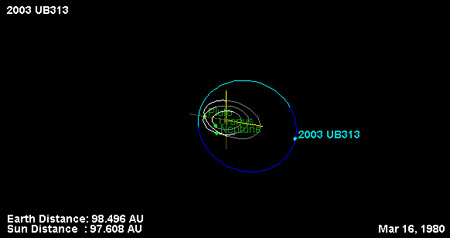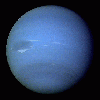|
|
|
 |
|
| Welcome to the Solar System Basics: |
|
Our Solar System now has eight planets - Pluto, Charon (actually still a moon of Pluto), Xena Eris and other soon to be discovered large KBO's and TNO's are now "dwarf planets." See my Blog for more details.
NASA Planetary Fact Sheet - Metric
NASA Planetary Fact Sheet - US Units
NASA Planetary Fact Sheet - Ratio to Earth Values
Planetary Fact Sheet Notes
Notes on the Fact Sheets
New members of our Solar System are still being discovered. Of recent notoriety: Eris (previously known as 2003 UB313)

The determination of this being an official dwarf planet has been determined by
the International Astronomical Union
- now officially called Eris - the unofficial name of this body is Xena. The image above is the discovery image.
On September 30, 2005, new data reveals Xena Eris has a moon -
Gabrielle.
| Eccentricity of Orbits: |
0.4378 |
| Semimajor Axis: |
67.89 AU |
| Greatest Distance from Sun: |
97.610 AU |
| Inclination: |
43.993 degrees |

As of right now, this object is designated as a
Trans Neptunian
Object (TNO) - similar to that of Sedna. The orbit is at least twice as large as
Pluto - as seen in the simulated orbit above (care
of NASA).
The Solar System is so named by its most prominent member - the
Sun. Going from center outward, the Solar System consists of the
Sun, 4
"terrestrial" planets, an
asteroid belt, and the four gas giant planets.
Pluto, the
Kuiper Belt
Objects (and
Trans Neptunian
Objects) and other dwarf planets, as well as the
Oort cloud follow. The Solar System
is HUGE but there is a lot of empty space. How big is it? Well,
light travels at
186,000 miles per second (300,000 km/s) and it takes over 8 minutes for light to
reach
Earth from the
Sun, and one hour for light to reach
Jupiter from the
Sun. |
| The drawing on the left shows the general
orbital structures of our Solar System. This drawing
is almost to scale, and demonstrates that the
distance between the planets is actually quite
large. Also notice how the orbit of
Pluto is, for a
relatively short time, closer to the
Sun and
Neptune. |
 |
The terrestrial planets:
Mercury,
Venus,
Earth and
Mars
(in order from in to out). These are called terrestrial
planets because they are a solid body, that is they have
land. Their density is almost equal because they are made
from rocky material.
Note: The images below, in order:
Mercury,
Venus,
Mars,
Jupiter,
Saturn,
Uranus,
Neptune, and
Pluto.
|
Earth's atmosphere is "just right." After
Mars, we have the
asteroid belt.
Do not be fooled by the movies because this area is
not that dense. When NASA sends their probes, they
pass through this region but they are not too
concerned about impacts because their is great
distances between each
asteroid. |
 |
|
 |
The asteroid belt exists because it is believed
that the strong gravity from
Jupiter prevents the debris to coalesce
into a planet. It is unknown as to how many
asteroids there are in this
region, but speculation is that if coalesced, a planet about the size of
Mars would form. |
|
After the
asteroid belt, we have the four gas giant planets (sometimes called Jovian planets which means "Jupiter-like"):
Jupiter,
Saturn,
Uranus, and
Neptune.
| All four of the planets are made mostly of gas
and their coloring is a result of varying
concentrations of methane and other gases. They all
have rings although
Saturn is most famous for its
prominent ring structure.
Jupiter is the largest
planet and sports a huge storm that has lasted
centuries called the "Great Red Spot." |
 |
|
 |
To dispel some science fiction,
Jupiter is not a
"failed star," that is if it were just a little more massive, it can collapse to
form a star. In reality, Jupiter would have to be between 8 and 16 times as
massive to begin contraction. The final "planet" we know to exist in the Solar System is
Pluto. |
|
 |
This debate has ended as the IAU, in 2006, declared Pluto a dwarf planet. In late 2005, there was a news article on a new planet called
Sedna.
This really isn't a planet, but an icy body. Depending on which group you ask,
some say Sedna is a
KBO, others a
TNO. So we'll let that go. |
|
| The final target of our voyage is the
Oort cloud. Jan Oort speculated that a
cloud of icy debris surround the entire Solar System, and that this is the
starting point for comets. As some nearby object disturbs the
Oort cloud, an icy
rock is "thrown" our way in the form of a
comet. |
 |
|
It is the random nature of the
comets orbit that is the evidence of the
Oort cloud. Had a comet come from
within the Solar System or from KBO's,
comets would only appear on the same
plane as the planets.
Summary:
There are eight planets in the Solar System:
Mercury,
Venus,
Earth,
Mars,
Jupiter,
Saturn,
Uranus, and
Neptune (and there is the dwarf planet
Pluto). The Solar System is also host to
asteroids,
comets,
Kuiper Belt
Object,
Trans Neptunian
Object, and the
Oort cloud.
The image above is designed to illustrate the apparent
sizes of each planet as related to each other (montage created from NASA JPL
images).
To learn more about a specific planet, please make your
selection on the upper left.
Back to Top
|
|

